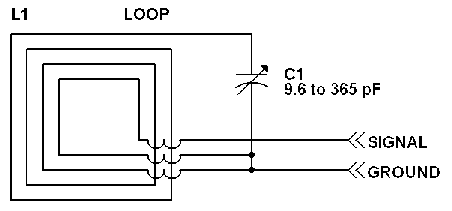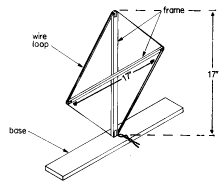AM Loop Antenna: Difference between revisions
Created page with " == site mirrors == === Wagner Ultimate AM Antenna === This web site appears to be down or no longer exist. Here is an archive of the information once contained. Carver Cor..." |
No edit summary |
||
| (6 intermediate revisions by one other user not shown) | |||
| Line 1: | Line 1: | ||
Medium Wave AM broadcast band resonant loop antenna | |||
An inductive winding and a tuning capacitor antenna design. | |||
[[File:ammfloopantenna01.png]] | |||
* The square loop is the inductor. | |||
* A tuning capacitor is connected. | |||
== site mirrors == | == site mirrors == | ||
| Line 14: | Line 21: | ||
#Twist the wire ends together approximately 2 turns per inch (I made a change here. On the base, I installed a two-wire terminal so I could easily connect a different length lead wire. I connected the ends of the wire from the loop to the terminal block and then connected a shielded wire to the terminal block to act as a lead-in. The ground (shield) lead connects to the ground terminal of the radio, the center wire connects to the "external AM antenna" terminal of the radio. You may have to experiment with your own radio to find what works best). | #Twist the wire ends together approximately 2 turns per inch (I made a change here. On the base, I installed a two-wire terminal so I could easily connect a different length lead wire. I connected the ends of the wire from the loop to the terminal block and then connected a shielded wire to the terminal block to act as a lead-in. The ground (shield) lead connects to the ground terminal of the radio, the center wire connects to the "external AM antenna" terminal of the radio. You may have to experiment with your own radio to find what works best). | ||
#Strip wire ends and connect to the AM terminals on the back of the radio (unless you used my changed design in 4 above). | #Strip wire ends and connect to the AM terminals on the back of the radio (unless you used my changed design in 4 above). | ||
[[File:wagnerMFAMantenna.gif]] | |||
The idea is that the size of the antenna acts as a long wire antenna, but the loop acts as a local noise eliminator. I have found it to work quite well in the Los Angeles area, where at night I can often pick up very distant stations with ease. | The idea is that the size of the antenna acts as a long wire antenna, but the loop acts as a local noise eliminator. I have found it to work quite well in the Los Angeles area, where at night I can often pick up very distant stations with ease. | ||
| Line 23: | Line 32: | ||
* [http://news.ccrane.com/2014/07/31/how-to-make-a-simple-powerful-am-loop-antenna-for-free/ How To Make a Simple Powerful AM Loop Antenna] | * [http://news.ccrane.com/2014/07/31/how-to-make-a-simple-powerful-am-loop-antenna-for-free/ How To Make a Simple Powerful AM Loop Antenna] | ||
* [http://makearadio.com/loops/index.php Dave's Homemade Loop Antennas] | |||
* [http://earmark.net/gesr/loop/ EarMark Productions AM loop antennas] | |||
[[Category:Radio]] | [[Category:Radio]] | ||
[[Category: | [[Category:Ham Radio]] | ||
Latest revision as of 17:28, 10 November 2015
Medium Wave AM broadcast band resonant loop antenna
An inductive winding and a tuning capacitor antenna design.
- The square loop is the inductor.
- A tuning capacitor is connected.
site mirrors
Wagner Ultimate AM Antenna
This web site appears to be down or no longer exist. Here is an archive of the information once contained.
Carver Corporation of Lynnwood, Washington once made the ultimate AM Stereo/FM Stereo tuner, the Carver TX-11b. The performance of this tuner was nothing short of spectacular on FM; the AM side was even more impressive, as it was designed to have an audio bandwidth of 20 Hz - 15 KHz -- the same as broadcast FM!
In order to receive clear AM Stereo signals -- on the TX-11b or any other AM radio, however, you have to have a good antenna. So Carver gave a plan for making what they called "The Ultimate AM Antenna." Here are the plans for this antenna.
- Construct a wood frame that measures 12 inches from point to point (17 inches across each bar).
- Secure the frame to a base.
- Wrap the frame with four turns of #22 insulated solid wire.
- Twist the wire ends together approximately 2 turns per inch (I made a change here. On the base, I installed a two-wire terminal so I could easily connect a different length lead wire. I connected the ends of the wire from the loop to the terminal block and then connected a shielded wire to the terminal block to act as a lead-in. The ground (shield) lead connects to the ground terminal of the radio, the center wire connects to the "external AM antenna" terminal of the radio. You may have to experiment with your own radio to find what works best).
- Strip wire ends and connect to the AM terminals on the back of the radio (unless you used my changed design in 4 above).
The idea is that the size of the antenna acts as a long wire antenna, but the loop acts as a local noise eliminator. I have found it to work quite well in the Los Angeles area, where at night I can often pick up very distant stations with ease.
Other ideas you may try are simple long wire antennas (good for distance or eliminating long-distance atmospheric noises) or if you are in an office that doesn't like the look of the "ultimate antenna," just placing a portable radio near a window.

